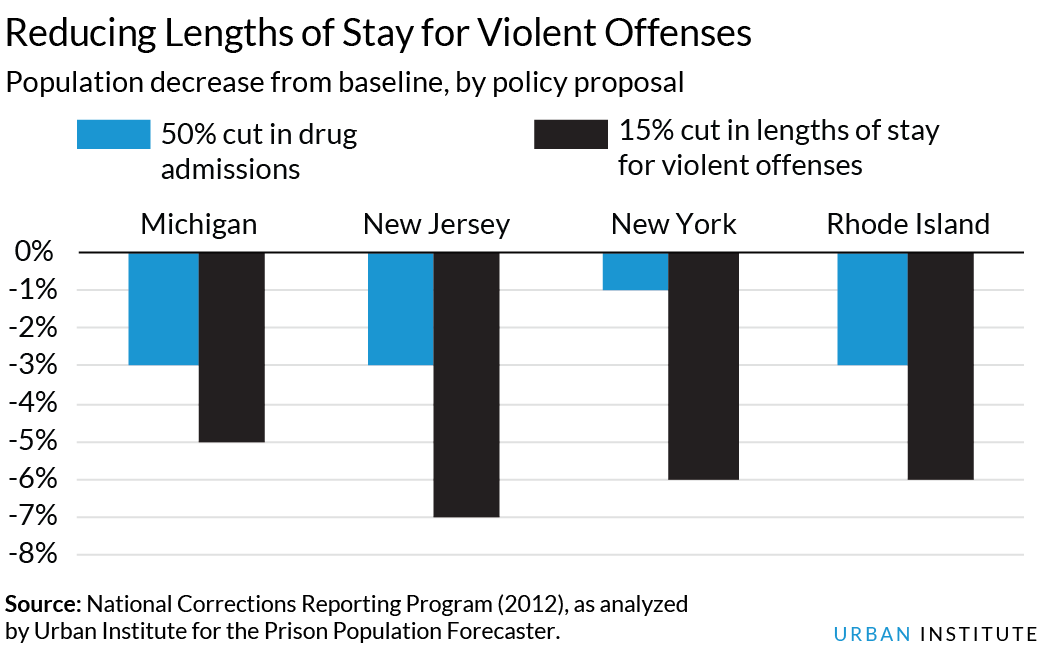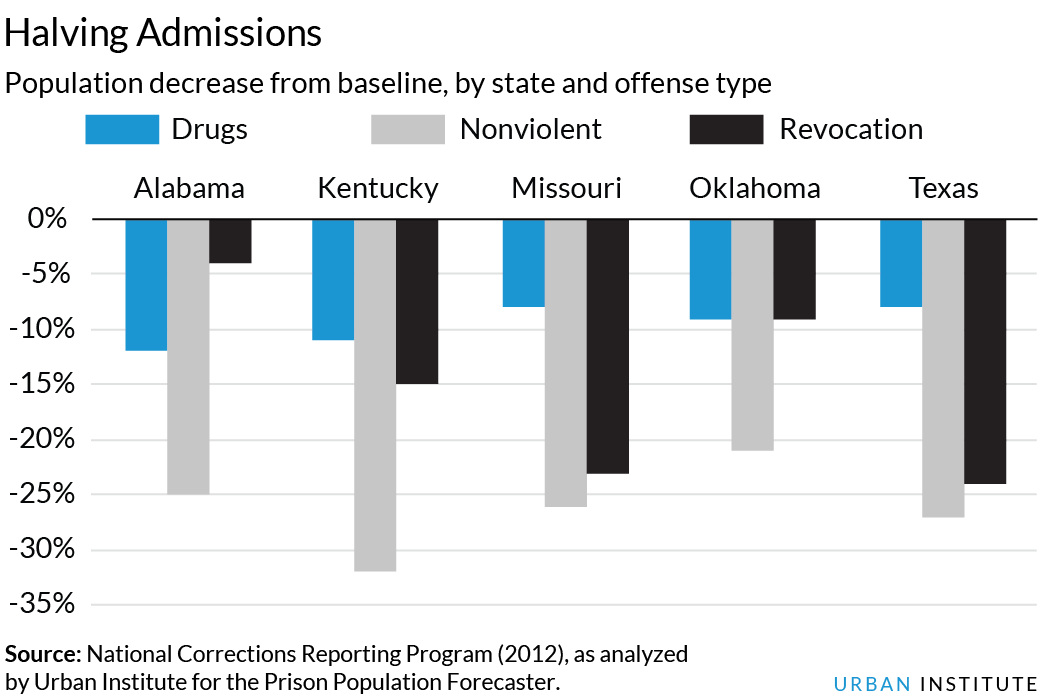Reducing Mass Incarceration Requires Far-Reaching Reforms
Ryan King, Bryce Peterson, Brian Elderbroom, and Elizabeth Pelletier
Roughly 2.2 million people are locked up in prison or jail; 7 million are under correctional control, which includes parole and probation; and more than $80 billion is spent on corrections every year.
Research has shown that policy changes over the past four decades have put more people in prison and kept them there longer, leading to exponential growth in the prison population even while crime has dropped to historic lows.
But despite widespread agreement that mass incarceration is a serious problem, the national conversation is light on details about what it will take to achieve meaningful and sustainable reductions. What do states actually need to do roll back their prison populations by 10 percent? 20 percent? 50 percent?
To advance the policy conversation, decisionmakers and the public need to know the impact of potential policy changes. Our Prison Population Forecaster can estimate the effect, by state, of policies that aim to reduce prison admissions and length of stay for the most common types of offenses.
The tool currently uses data from 15 states, representing nearly 40 percent of the national prison population, to forecast population trends and project the impact of changes on rates of admission or lengths of stay in prison.
Using the tool, we can see that in some states, limiting prison admissions to only new crimes and diverting parole and probation revocations will substantially reduce the number of people behind bars. Other states can stem prison growth by tackling how they address drug and property offenses. Still others may discover that modest reductions in time served for violent offenses are necessary.
This forecasting tool paves the way for a more productive conversation about the need for tailored reforms that address the unique drivers of mass incarceration in each jurisdiction.
Rethinking who goes to prison and how long they stay
After nearly 40 years of unabated growth, the state prison population has begun to level off in some states and decline in many others. Many states have reduced prison admissions for drug possession and other less serious offenses, taking a critical first step in alleviating the harms caused by incarceration. The positive effect of these reforms on individuals, families, and communities should not be understated. These reforms have helped stem the tide of prison growth but they will not be sufficient to further cut the prison population dramatically.
If the 15 states in our forecaster make no policy changes and current trends hold constant, the prison population in those states is forecasted to decline only 2 percent by the end of 2021.
Accelerating this decline to make a real dent in mass incarceration will require us to fundamentally rethink whom we send to prison and how long they stay. For example, cutting total admissions in half for the 15 states in the forecaster (click to see this scenario)—a lofty goal—would reduce their collective prison population by 37 percent through 2021. Halving lengths of stay would cut the population by 39 percent. These scenarios include all offense types and are far beyond the scope of reforms being discussed at the state level.
Drug offenses
Over the past few years, many states have begun to reform their laws and reduce the number of people admitted to prison for drug offenses. According to the Bureau of Justice Statistics, prison admissions for drug-related crimes declined 22 percent between 2006 and 2011.
Looking at all 15 states in the forecaster, another 15 percent reduction in drug admissions would result in a prison population that is 2 percent smaller by the end of 2021 than the projected baseline population—in other words, it would be 2 percent smaller than if we did nothing.
Cutting drug admissions in half would shrink the prison population by 7 percent, or almost 33,000 inmates, by the end of 2021. Reducing lengths of stay for drug offenses by 15 percent or 50 percent would yield similar results.
These numbers underscore the message that tackling mass incarceration will require reforms that reduce admissions or lengths of stay for other offenses. About 1 in 6 people in state prison is incarcerated for a drug conviction, and far fewer are incarcerated for low-level drug offenses, such as possession. Even if every person in state prison for a drug offense were released today, mass incarceration would persist.
Other nonviolent offenses
States have begun reforming sentencing policies for property offenses, a category that includes burglary, theft, and fraud. But these reforms, such as raising the felony-theft threshold, affect a small number of those convicted of the least serious property offenses. Policy changes that cut admissions and lengths of stay for a wider range of property offenses therefore hold great potential for reducing mass incarceration. For example, for the states in the forecaster, sending 50 percent fewer people to prison for property offenses would have 1.5 times the impact of reducing drug admissions by the same amount.
Looking at all nonviolent offenses (drug, property, and other), the forecaster projects that halving admissions would cut the prison population by 23 percent by 2021. This is a significant change, resulting in 110,000 fewer people in prison in these 15 states. Reducing lengths of stay for all nonviolent offenses would result in similar changes.
Parole and probation violations
Many states are also reconsidering how they address technical violations of probation and parole, such as failing a drug test. These changes may include restricting how long people stay in prison when they return for a technical violation, or diverting them from prison entirely. Building on these reforms holds the promise of significantly shrinking the prison population. For example, cutting in half the number of people sent to prison for a revocation would result in a 14 percent reduction in the prison population of the forecaster states by the end of 2021.

Violent offenses
The estimates for all 15 states obscure important variation between states. Each state has a wide range of policies that affect length of prison sentences and eligibility for release. And the effects of reforms will vary widely. This is particularly true when exploring the effects of reducing admissions or lengths of stay for nonviolent versus violent offenses.
More than half of people in state prisons are incarcerated for a violent offense, so significantly reducing mass incarceration will require addressing lengths of stay for crimes that are unlikely to be eligible for prison diversion programs.

In four of the states in our forecaster—Michigan, New Jersey, New York, and Rhode Island—reducing lengths of stay for violent offenses by a modest 15 percent would result in a much larger drop in the prison population than reducing drug admissions by 50 percent.
In New York, one of the first states to revisit its mandatory minimum penalties and create alternatives to incarceration, sending 50 percent fewer people to prison for drug crimes would result in only a 1 percent decline in the projected prison population through 2021. Reducing lengths of stay for violent offenses by just 15 percent, however, would reduce the population by 6 percent.
Is there any low-hanging fruit left?
In short: yes. While dramatically reducing the national prison population requires addressing the hard stuff—like long prison sentences and time served for violent offenses—reforms to drug laws and revocation policies will still go a long way in many states.
For example, nonviolent offenses are a major driver of the prison population in Alabama, Kentucky, Missouri, Oklahoma, and Texas, so sending fewer people to prison for drug and property crimes would have a big impact on incarceration rates. Halving drug admissions would cut the prison population by nearly 10 percent in each of those states by the end of 2021. And a 50 percent reduction in admissions for all nonviolent crimes would cut at least a quarter off their populations (nearly a third in Kentucky).

The policy reality in Missouri and Texas stands in even starker contrast to states such as New York and New Jersey. In Missouri and Texas, reducing admissions for revocations of probation and parole supervision by 50 percent is projected to cut the prison population by nearly a quarter by the end of 2021. Given that many of these revocations are likely due to technical violations and not new crimes, there is plenty of low-hanging fruit to be picked for reform.
A combination of reforms will be necessary
The mass incarceration debate too often gets mired in false choices between addressing the problem on the front or back end (admissions versus length of stay) and questions about the relative impact of focusing on nonviolent or violent offenses, without a detailed understanding of how policy changes would affect the size of the prison population.
Our forecasting tool sheds some light on the effects of potential reforms. However, no single policy change is sufficient to make meaningful reductions in the prison population, so policymakers will need to explore a combination of reforms. For now, our forecaster cannot model multiple scenarios simultaneously—such as what would happen if states cut admissions for drug offenses by 25 percent and for property offenses by 15 percent—but we plan to include this capability, more states, and demographic data in the next version.
Pairing further reductions in admissions for drug and property offenses with reductions in lengths of stay for violent offenses is the surest way to meaningfully and sustainably reduce the prison population. The forecaster shines a bright light on that reality and drives home the point that significant across-the-board policy changes are necessary to reduce mass incarceration.





